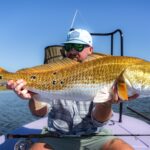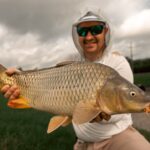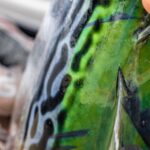
Louisiana Bull Reds Up for Harvest Again: H.B. 604 Must Not Pass
Photo Credit: Carter Abramson | Trevor Johnson Every now and then, we encounter something so
A few angling opportunities anchor my annual fishing calendar, notably pre-spawn smallmouth and the spring migrations for tarpon and striped bass. I’ve been fortunate to chase the latter throughout their entire migratory range. One of my favorite stops along this journey is Cape Cod. The Cape is incredibly beautiful and offers a unique angling experience not available at hotspots along the migration route. Crystal-clear water on shallow flats, roaring offshore rips and tidal backwater creeks top the list of dynamic locations to throw lures and feathers to line siders.
Timed perfectly to coincide with the striped invasion of the Cape’s sandy shores, the Cheeky Schoolie Tournament is a special community event focused on honoring and protecting our beloved striped bass. This tournament brings like-minded anglers together to celebrate stripers while raising awareness of the fisheries’ issues and fundraising for the organizations fighting to protect them. This tournament has grown exponentially in its 12-year history and now touts sponsorship and promotion from top fly fishing brands such as Yeti, Costa and Scientific Anglers.
I was eager and excited to return to the Cape last month to participate. The tournament starts with a “meet & greet” Captain’s Party on Friday, reviewing fishing rules while enjoying catered food and exploring sponsor booths. As a striped bass advocate who wants to ensure we have angling opportunities for future generations, I appreciate Cheeky’s continued effort to evolve the rules to match best practices and minimize the impact of such a large single-day fishing effort. The Captain’s party is a great time; all participants receive a nice swag bag, some commemorative goods and lots of fishy energy as they prepare for the long 10+ hour fishing day.
My experience at the Schoolie Tournament is focused on something other than securing a spot on the podium. The biggest reward of attending the event each year is rekindling old friendships, creating new memories and swapping fishing stories. To create the experience I want from the event, I intentionally take the less tactical route, ignoring maps and tide charts and instead exploring with an open mind. Most of the trip is spent soaking up the environment and documenting all that comes with it. This year my teammate was fellow YETI ambassador and good friend Jeff Currier. We were accompanied by photographer Ricky Griffiths, who has covered the event for the last three years on behalf of the iconic cooler brand. Jeff and I have known each other for over two decades but never had the chance to fish together, so we were both incredibly excited when YETI offered to foster this opportunity. For those of you who may not be aware of his career, Jeff has been in the fly fishing industry for as long as I have, if not longer. He’s done it all; from incredible artwork to industry ambassadorship and managing one of the most iconic shops in Jackson Hole. I greatly appreciate Jeff’s resume as a traveling angler who takes the DIY approach. If you can think of a destination, chances are Jeff has been there and done that before those places even become known in mainstream media. Next to Larry Dahlberg, I’m not sure of anyone else that has explored the world more than Jeff – especially on his own.
Our team got a late start on tournament day, aligning well with our team ethos of prioritizing a good time. It was evident during our discussions while wadering up that Jeff’s passion still shines through. After all of these years, he still loves the sport and hasn’t lost an ounce of excitement for every new day’s adventure. We started out fishing a creek mouth on the incoming tide, aiming to meet some hungry stripers flooding into the shallows with the bait. After a short session and a little photo shoot, we hiked into a new spot with the hope of stacking up a catch-log. The “walk-and-wade only” dynamic of this tournament presents a very unique challenge. Your ability to rapidly change your strategy and location is significantly weaker without a hull and outboard. This takes a lot of great boat spots out of the equation, levels the playing field and creates a need for sound strategy.
One of the most magical things about fishing on Cape Cod is the clear water that generates incredible sight-fishing opportunities. The ability to read the water and get a view into the fish’s world is vital. Anglers can read travel paths and line up interception points with a little tact. Jeff and I decided to way out to the very end of the creek where it opens up into the ocean, thinking that the deeper cut may present an easier opening for stripers to use as a highway to pinch bait on the turning tide. Luckily for us, there were two kayak anglers already out front and we could see them getting into fish. While they were outside our range, that was a great sign. This game plan quickly proved to be fruitful, as Jeff connected to the first fish on a popper.
We quickly landed the measurable striper and photographed it before a quick and thoughtful release. The Schoolie tournament requires a minimum length of 20″ for fish to count for points. This was a recent addition to the rules and a fantastic one, as it reduces the pressure on smaller fish and minimizes the handling time for fish that won’t affect the scoreboard. I was fortunate to hook up next on a Jerk Changer burned on the two-hand strip; what an epic bite. As a team, we scored a handful of bites but those fish didn’t stay buttoned. With the extreme tidal swing in New England and a surging incoming tide rushing through our legs, we reluctantly left this spot and waded across the creek while it was still an option. This was a tough decision. We were surrounded by life, and as they say: “never leave fish to find fish”. We couldn’t wander our way into much more action after leaving that creek so we did a little photo shoot on the water with Ricky before returning to get ready for the evening events.
The evening festivities consisted of an awards ceremony, more great food and plenty of shared “what could have been” stories from tournament day. We heard plenty of “what we should have done”, along with many about “the one that got away”. This year we had our own versions to share, which is one of the fun parts of participating in a tournament. There were plenty of really nice size fish landed by other teams with plenty of high scores topping the leaderboard. While this tournament is appropriately named “The Schoolie” due to its seasonal timing, the average class of fish landed this year was larger with many fish between 28-34″. Many of these fish are members of the 2015-year class that ASGA and the striped bass community have been rallying to protect. Seeing so many anglers experience these fish was both heart-warming and concerning, being in tune with the current Emergency Action process from the ASMFC Striped Bass Management Board. The tournament ceremonies were completed with a fundraising presentation to non-profit organizations on the frontlines of striped bass management and education – including ASGA. It was fantastic to see well over $30,000 being split between the organizations and hearing representatives from each get a minute on the microphone to inform and educate participants.
While many tournament competitors packed their bags with hopes for next year’s event, my plans were a little different. I stayed on the Cape to connect with an amazing videographer, Oliver Sutro, to execute a film shoot for Temple Fork Outfitters’ new rod launch. We had a couple of days scheduled with Captain Diogo Godoi from Gorilla Tactics Sport Fishing. We had an amazing time and recorded so much epic footage of slot to overslot-sized fishing crushing Jerk Changers. We even broke into the 40″ class. It doesn’t get much better than that.
I had several major takeaways from this year’s trip to the Cape. First and foremost, I have an overwhelming feeling of pride being a member of the striped bass community that is all-in on protecting the future of this fishery. Second, it is very clear that we are in trouble, as we continue to watch this fishery change significantly over the past several years. There seems to be a lot of debate over the state of the fishery and the science behind it. ASGA has rightly questioned: where doesn’t the data line up with what we’re seeing? The data shows that we have this incredible year class around the slot, a solid population of larger fish but no healthy classes coming down the pipeline to keep us trending upward. I heard many comments from tournament competitors about how few “micro” fish they interacted with this year. It’s easy to look through a keyhole and think the fishing is better because the size of the fish being caught in numbers is larger. However, when you open the door, the lack of other year classes behind it is alarming. I’ve sat in on online management meetings over the last year, hearing the opposition to conservation-minded voices celebrating how good the fishing is. I wish I could help them understand how short-sighted that perspective is.
If there’s one thing I do know, it’s getting the chance to chase striped bass and experience all the areas they live and utilize along their migratory route is a privilege, not a right. This trip was refreshing and stands as a reminder of what we are fighting for, renewing my purpose to speak up for striped bass. I want to thank everyone involved in this process and remind them to stay diligent – their voices will be heard. We can’t protect these incredible fish and secure their future without you.
Blane Chocklett
Feature Photo Credit: Oliver Sutro

Photo Credit: Carter Abramson | Trevor Johnson Every now and then, we encounter something so

This past weekend, ASGA proudly sponsored the Dirty Carp Tournament in Louisiana — and no, you didn’t misread that.

After years of data pouring in from The Albie Project, advocacy, persistence, and support from

This morning, the Connecticut Environment Committee held a hearing on House Bill 6248, a bill
We rely on our members and donations to keep fighting for a sustainable tomorrow in marine conservation.
GIVE THE GIFT OF FISHERIES CONSERVATION THIS HOLIDAY SEASON. SHOP ASGA GOODS THAT FUND FISHERIES RESEARCH & ADVOCACY CAMPAIGNS
JOIN ASGA IN CALLING FOR CRITICAL MANAGEMENT ACTION AFTER YEARS OF SPAWN FAILURES & POOR MANAGEMENT.
By using this website, you agree to our use of cookies. We use cookies to provide you with a great experience and to help our website run effectively. To learn more, please review our privacy policy.